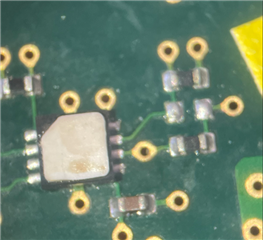Tool/software:
We noticed a browned appearance on a component that we assembled by hand (it's our prototype process, temperature is less well-controlled).

We therefore believe that the component is damaged and we are wondering about the rework conditions.
According to the datasheet, here are the conditions:
8.4.3.3 Rework
TI recommends to limit the HDC302x to a single IR reflow with no rework, but a second reflow can be possible if
the following guidelines are met:
• The exposed polymer (humidity sensor) is kept clean and undamaged.
• No-clean solder paste is used and the process is not exposed to any liquids, such as water or solvents.
• The peak soldering temperature does not exceed 260°C.
Can please precise point below?
- No rework ==> Does this mean that all soldering rework is prohibited and therefore component replacement is necessary? Or does the entire board have to be scrapped ?
- Can you also specify if there are specific hand soldering instructions? Except for the indication not to exceed 260°C

